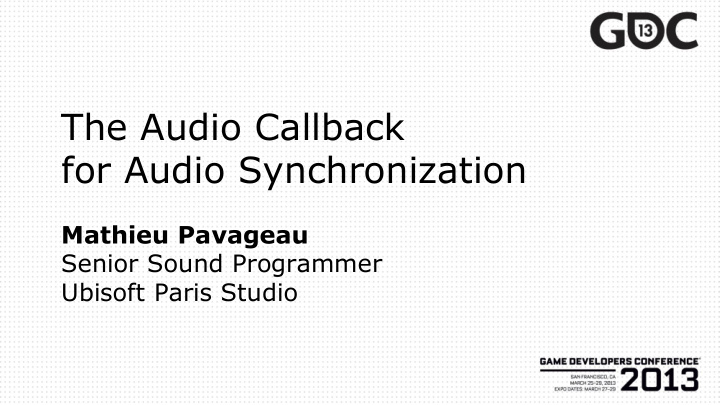



The Audio Callback for Audio Synchronization Mathieu Pavageau Senior Sound Programmer Ubisoft Paris Studio
Sound Programming Experience … ● 2003 2003 2004 2005 2011 + Sound Middleware + R&D
Outline ● Musical Interactivity ● Audio Engines in Games ● Audio needs a fast update context ● Implementing the Audio Callback ● Examples
Musical Interactivity ● Musical Content reacts to Gameplay ● Music and Gameplay designed together
Example: Mickey Mousing Example Mickey-Mousing Example: Rayman Origins Menu
²
Current Musical Interactivity
Either Pre-Recorded Audio One music track at a time ● Or multitracks/multilayers ● High Quality Audio BUT Little Musical Interactivity
Or MIDI System ● Musical Score can be modified in real-time ● Uses Sound Banks High Musical Interactivity BUT Low Audio Quality
Synchronizing Audio with Audio
Synchronization: Design ● Musical Structure: data with the wave ● Play new sounds sync with playing sounds
Synchronization: Design
But: V-Sync is Master Clock ● V-Sync image update ● Video frame is Master Clock (FPS) ● Entire Game updated with V-Sync All Audio Requests made in Video Frame
Duration of Game Frame Frame Rate Duration 60 FPS (60 Hz TV) 17 ms 50 FPS (50 Hz TV) 20 ms 30 FPS (60 Hz TV) 33 ms 25 FPS (50 Hz TV) 40 ms 17 ms is the best time precision for audio
Without the Audio Callback: No Sync
Time Perception Examples (1) 0 ms 5 ms 10 ms A B C D E A F G
Time Perception Examples (2) 15 ms 20 ms 25 ms A B C D E A F G
Time Perception for Audio ● Synchronized sounds require a precision of a few milliseconds ● Musical precision does not need sample to sample precision
Audio Synchronization needs a fast update context: The Audio Callback
The Audio Callback ● Hardware related: it already exists! Audio Output Hardware ● Same as CoreAudio, ASIO, etc ● Sound engines use it asynchronously Regular filling-up of audio buffers for the hardware
Audio Callback on Consoles ● Wii/WiiU: AX callback (3 ms) ● PS3: audio update thread (5 ms) ● XB360: XAudio2 callbacks (5 ms)
With the Audio Callback: Audio Sync
Audio Callback Implementation
Implementation: Precautions ● Callback cannot be slowed down ● Lockless programming ● Some operations are forbidden (ex CreateVoice on XAudio2)
Architecture ● Low level audio must expose the Audio Callback to the game/client (for interactivity with the game) ● It’s difficult to modify existing sound engines to use the Audio Callback
Advantages Stable audio, not affected by FPS drop ● Behaves the same rhythmically when ● ported on different platforms
Examples in Ubisoft Games
Synchronized Play Requests ● Dynamic Multitracks ● PlayOnNextBar, PlayOnNextBeat, etc…
● Click to edit Master text styles ● Second level ● Third level ● Fourth level ● Fifth level Example: Rayman Origins Menu
Without sync
With sync
Example: Rayman Origins Intro
Summary ● Audio synchronization can be implemented using the Audio Callback ● Audio synchronization enables better audio interactivity ● Audio interaction requires sharing code with the game: Architecture
What Next? ● Next Gen machines will give even more power to audio ● More process can be done in the Audio Callback (effects, software mix, entire DAW…) ● Mickey Mousing one day in video games!
Questions? More info: mathieu.pavageau@ubisoft.com
Recommend
More recommend